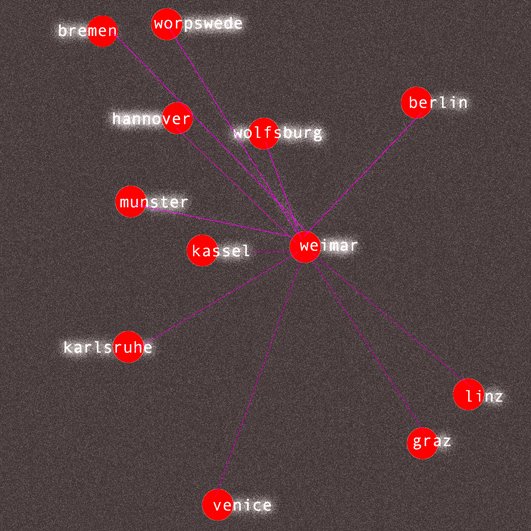Terra incognita
Since November 2006 I had been taking part of a project in the city of Worspwede. Due to the small distance that separates this place from Bremen and the frequency of visits I needed to do in order to fulfill the project, I went to the Kunsthalle in Bremen several times. On one occasion around February 2007, I saw a very well done intervention of an artist, who working as curator within the collection of the museum developed a systematic strategy to show not only the pieces in the collection and the relation between them, but at the same time, the intimate constitution of the museum itself. Instead of covering and protecting the places like deposits and wall structures; or working with the white cube nor simply hanging the classical pictures in the wall, Wolfang Hainke’s terra incognita/Topsy-Turvy Topography showed the inside of the museum as a “museographic dispositive”.
Hainke offered an interesting view of the contents of the museum by studying every work in relationship to the other pieces inside the collection, to the point that it was easy to understand the reason and the moment when the acquisition of the work had been made. On the other hand with very black humor and in a satirical cadence, he established absurd but firm relationships between different pieces, giving the collection a fresh air and making attractive a collection otherwise not frequently visited by the population of the surrounding area.
In between the strategies used by this artist to express his ideas around curatorial affairs were:
• He used an immaculate “museography” with a very strong emphasis in alternative use of pedestals and structures. For example, by showing the classical sculptures of the collection as a contemporary installation that were observed through a hole in the wall, giving the opportunity to see the layers of the drywall. To my concern this installation introduced a very strong position in terms of the inside-outside of the museum, expressed from a very structural and physical discourse.

• He used very anarchic way of setting up technical information by showing structures used only in the deposits of the museum to preserve the work of art and implementing a series of maps of information similar to the ones used to find the pieces in the deposits, almost technical drawings of distribution.

• He used montage structures like ladders and scaffoldings to separate spaces, demystifying the severe aura of the museum and transforming the place in a constant mutable space.

To my concern this was a very well done exhibition with a profound reflection of the role of the contemporary museum and with a systematic study of the structure of a collection, a source for rebuilding a procedure of the construction of ideas inside the wide structure of the museum.
Since November 2006 I had been taking part of a project in the city of Worspwede. Due to the small distance that separates this place from Bremen and the frequency of visits I needed to do in order to fulfill the project, I went to the Kunsthalle in Bremen several times. On one occasion around February 2007, I saw a very well done intervention of an artist, who working as curator within the collection of the museum developed a systematic strategy to show not only the pieces in the collection and the relation between them, but at the same time, the intimate constitution of the museum itself. Instead of covering and protecting the places like deposits and wall structures; or working with the white cube nor simply hanging the classical pictures in the wall, Wolfang Hainke’s terra incognita/Topsy-Turvy Topography showed the inside of the museum as a “museographic dispositive”.
Hainke offered an interesting view of the contents of the museum by studying every work in relationship to the other pieces inside the collection, to the point that it was easy to understand the reason and the moment when the acquisition of the work had been made. On the other hand with very black humor and in a satirical cadence, he established absurd but firm relationships between different pieces, giving the collection a fresh air and making attractive a collection otherwise not frequently visited by the population of the surrounding area.
In between the strategies used by this artist to express his ideas around curatorial affairs were:
• He used an immaculate “museography” with a very strong emphasis in alternative use of pedestals and structures. For example, by showing the classical sculptures of the collection as a contemporary installation that were observed through a hole in the wall, giving the opportunity to see the layers of the drywall. To my concern this installation introduced a very strong position in terms of the inside-outside of the museum, expressed from a very structural and physical discourse.

• He used very anarchic way of setting up technical information by showing structures used only in the deposits of the museum to preserve the work of art and implementing a series of maps of information similar to the ones used to find the pieces in the deposits, almost technical drawings of distribution.

• He used montage structures like ladders and scaffoldings to separate spaces, demystifying the severe aura of the museum and transforming the place in a constant mutable space.

To my concern this was a very well done exhibition with a profound reflection of the role of the contemporary museum and with a systematic study of the structure of a collection, a source for rebuilding a procedure of the construction of ideas inside the wide structure of the museum.

